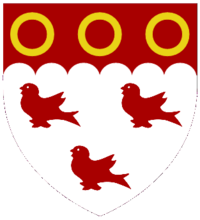|
Earl Cowper
 Earl Cowper (/ˈkuːpər/ KOO-pər) was a title in the Peerage of Great Britain. It was created in 1718 by George I for William Cowper, 1st Baron Cowper, his first Lord Chancellor, with remainder in default of male issue of his own to his younger brother, Spencer Cowper. Cowper had already been created Baron Cowper of Wingham in the County of Kent, in the Peerage of England on 14 December 1706, with normal remainder to the heirs male of his body, and was made Viscount Fordwich, in the County of Kent, at the same time as he was given the earldom, also Peerage of Great Britain and with similar remainder. He was the great-grandson of William Cowper, who was created a Baronet, of Ratling Court in the County of Kent, in the Baronetage of England on 4 March 1642. The latter was succeeded by his grandson, the second Baronet. He represented Hertford in Parliament. He was succeeded by his eldest son, the aforementioned William Cowper, the third Baronet, who was elevated to the peerage as Baron Cowper in 1706 and made Earl Cowper in 1718. In 1706 Lord Cowper married as his second wife Mary Clavering, daughter of John Clavering, of Chopwell, County Durham. Lord Cowper was succeeded by his son, the second Earl. He assumed the additional surname of Clavering. Cowper married Lady Henrietta, younger daughter of Henry de Nassau d'Auverquerque, 1st Earl of Grantham, a relative of the Dutch House of Orange-Nassau, and a count of the Holy Roman Empire. On the death of Lady Cowper's elder sister, Lady Frances Elliot, in 1772, the second Earl's son, the third Earl became Lord Grantham's heir general, and on 31 January 1778 he was created a Prince of the Holy Roman Empire (Reichsfürst) by the Emperor Joseph II.[1] He was allowed by George III to bear this title in Great Britain. Lord Cowper's second son, the fifth Earl (who succeeded on the early death of his unmarried elder brother), was a Fellow of the Royal Society. The latter was succeeded by his eldest son, the sixth Earl. He represented Canterbury in Parliament and served as Lord Lieutenant of Kent. Lord Cowper married the Hon. Anne Florence, daughter of Thomas de Grey, 2nd Earl de Grey and 6th Baron Lucas. In 1859 she succeeded her father as 7th Baroness Lucas. They were both succeeded by their son, the seventh Earl and eighth Baron Lucas. He was a Liberal politician and served as Lord-Lieutenant of Ireland between 1880 and 1882. In 1871 managed to obtain a reversal of the attainder of the Scottish Lordship of Dingwall, which had been under attainder since 1715, and became the 4th Lord Dingwall as well. Lord Cowper was childless and on his death in 1905 the baronetcy of Ratling Court, the barony of Cowper, the viscountcy, the earldom and the Princely title became extinct. He was succeeded in the barony of Lucas of Crudwell and the lordship of Dingwall by his nephew; see Baron Lucas and Lord Dingwall for further history of these titles. Several other members of the family may also be mentioned. Spencer Cowper, younger son of the second Baronet and brother of the first Earl, was a politician and barrister. He was the father of 1) Ashley Cowper, Clerk of Parliaments; 2) William Cowper, Clerk of Parliaments, the father of a) William Cowper, Member of Parliament for Hertford and b) Spencer Cowper, a Lieutenant-General in the British Army, who was the father of Henry Cowper, Clerk of the House of Lords; and 3) Reverend John Cowper, father of the poet William Cowper. William Cowper-Temple, 1st Baron Mount Temple, was the second son of the fifth Earl. The Hon. Henry Cowper, second son of the sixth Earl, was Member of Parliament for Hertfordshire for many years. The family seat of the Earls Cowper was Panshanger in Hertfordshire. Other seats included Wrest Park in Bedfordshire, Brocket Hall in Hertfordshire, Melbourne Hall in Derbyshire and a townhouse at 4 St James's Square. Cowper baronets, of Ratling Court (1642)
Earls Cowper (1718) 
Family tree
Arms
See alsoReferences
|
|||||||||||||||||||||||||||||||||||||||||||||||||||||||||||||||||||||||||||||||||||||||||||||||||||||||||||||||||||||||||||||||||||||||||||||||||||||||||||||||||||||||||||||||||||||||||||||||||||||||||||||||||||||||||||||||||||||||||||||||||||||||||||||||||||||||||||||||||||||||||||||||||||||||||||||||||||||||||||||||||||||||||||||||||||||||||||||||||||||||||||||||||||||||||||||||||||||||||||||||||||||||||||||||||||||||||||||||||||||||||||||||||||||||||||||||||||||||||||||||||||||||||||||||||||||||||||||||||||||||||||||||||||||||||||||||||||||||||||||||||||||||||||||||||||||||||||||||||||||||||||||||||||||||||||||||||||||||||||||||||||||||||||||||||||||||||||||||||||||||||||||||||||||||||||||||||||||||||||||||||||||||||||||||||||||||||||||||||||||||||||||||||||||||||||||||||||||||||||||||||||||||||||||||||||||||||||||||||||||||||||||||||||||||||||||||||||||||||||||||||||||||||||||||||||||||||||||||||||||||||||||||||||||||||||||||||||||||||||||||||||||||||||||||||||||||||||||||||||||||
Portal di Ensiklopedia Dunia

